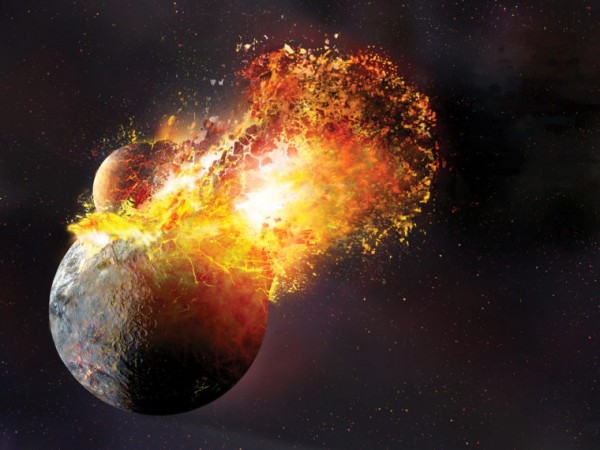By Ana Verayo, | September 13, 2016

An artist's conception of the giant impact that created Earth's moon. New research suggests the impact was even more violent than this image suggests.
Scientists have solved the mystery about the origins of our moon. New isotopic analysis has revealed that the moon was forged from the young Earth's mantle billions of years ago.
Past studies and models had indicated that the moon originated from another planetary body the size of Mars and Earth.
Like Us on Facebook
This model also explained how the moon acquired its distinct shape and features including its overall shape and rotation.
Past research also claimed that the moon's composition was mostly made from its impactor. In this new study, this model is debunked by new isotopic evidence, suggesting that Earth and lunar samples have almost similar concentrations of three oxygen isotopes.
What are isotopes? They are chemical signatures similar to fingerprints that are present in the planetary objects within the solar system.
The new findings are the most precise isotopic measurements yet, according to geochemist Kun Wang from the Washington University in St. Louis, Adding that they are still identical.
The researchers have proposed a theory that a high energy impact must have vaporized most of proto-Earth, which created a massive magma atmosphere which mixed Earth materials and its impactor. During this melted rock haze, the Earth slowly healed and reformed as the moon was also born.
This new analysis reveals potassium isotope levels supporting this high energy impact theory that are both found in lunar and terrestrial rocks and material.
According to Wang, this heavy potassium isotope embedded in lunar rocks and on the Earth can be best explained as a result of an incomplete condensation of bulk silicate vapor. However, enrichment of lunar rocks with heavier potassium isotopes cannot be explained by a silicon vapor atmosphere.
The researchers concluded that their K isotope results are inconsistent with low energy disk equilibrium model, but supports a high energy, high angular momentum giant impact model for the origin of the moon.
This new study has been published in the journal Nature.
-
Use of Coronavirus Pandemic Drones Raises Privacy Concerns: Drones Spread Fear, Local Officials Say

-
Coronavirus Hampers The Delivery Of Lockheed Martin F-35 Stealth Fighters For 2020

-
Instagram Speeds Up Plans to Add Account Memorialization Feature Due to COVID-19 Deaths

-
NASA: Perseverance Plans to Bring 'Mars Rock' to Earth in 2031

-
600 Dead And 3,000 In The Hospital as Iranians Believed Drinking High-Concentrations of Alcohol Can Cure The Coronavirus

-
600 Dead And 3,000 In The Hospital as Iranians Believed Drinking High-Concentrations of Alcohol Can Cure The Coronavirus

-
COVID-19: Doctors, Nurses Use Virtual Reality to Learn New Skills in Treating Coronavirus Patients







